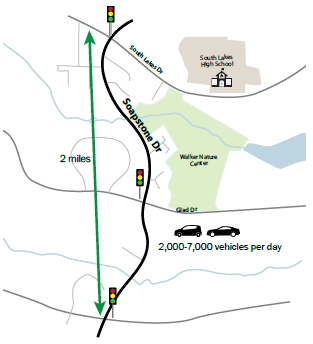THERE'S MORE THAN ONE WAY TO COMPLETE A ROAD DIET
| Objective | Features | Results |
|---|---|---|
|
|
|
BACKGROUND

The success of the Road Diet on Lawyers Road convinced the Virginia Department of Transportation (VDOT) to try their second conversion on nearby Soapstone Drive. VDOT once again took advantage of a regularly-scheduled repaving project to implement the Road Diet which stretched from Sunrise Valley Drive to Lawyers Road. Carrying 2,000 to 7,000 vehicles per day, the cross section, land use, and speed limit vary on this nearly 2-mile segment of Soapstone Road, requiring a number of different reconfigurations along the corridor.
The most typical Road Diet conversion transforms a roadway with two lanes in each direction to a road with a single lane in each direction and a center turn lane, with the extra space often being used for bicycle lanes or parking. VDOT's Road Diet on Soapstone Road highlights a variety of ways a Road Diet can be implemented.
SUNRISE VALLEY DRIVE TO SOUTH LAKES DRIVE
This 35 mph section of Soapstone Drive is more urban than the following segments, with sidewalks, multi-family housing, and light retail. A golf course and an elementary school are located nearby.

SOUTH LAKES DRIVE TO GLADE DRIVE
South Lakes Drive to Glade Drive has a wider cross-section and is located adjacent to the Walker Nature Center. With a mix of multifamily housing and commercial activity on one end and woodland areas and single family homes on the other, this middle section is transitioning from urban to a slightly rural feel.

GLADE DRIVE TO LAWYERS ROAD
While not a traditional Road Diet, VDOT restriped 18-ft lanes down to 12-ft and carried the bicycle lanes throughout. With a speed limit of 25 mph, this section of Soapstone Road includes low-density residential neighborhoods with single family homes. The surrounding land contains woodland areas and parks with recreational trails that attract pedestrian and bicycle traffic.

RESULTS
- Much like the success on Lawyers Road, the Road Diet on Soapstone Road achieved great results, improving safety with a crash reduction of 70 percent.
- The resulting linked network of bicycle lanes on Soapstone Road and Lawyers Road provides an excellent travel option for access to the nearby transit station.
- The success of the Reston projects is leading VDOT to greatly expand its use of Road Diets regionwide.
"A big thank you to VDOT for having the vision to modify Soapstone and Lawyers, making both roads safer for everyone and creating dedicated bike facilities for cyclists."1
FABB Blog: Fairfax Advocates for Better Bicycling
1 Bruce Wright, "Soapstone Bike Lane Project Starts Monday," FABB Blog – Fairfax Advocates for Better Bicycling. October 14, 2011. Accessed March 23, 2015. Available at: http://fabb-bikes.blogspot.com/2011_10_01_archive.html
